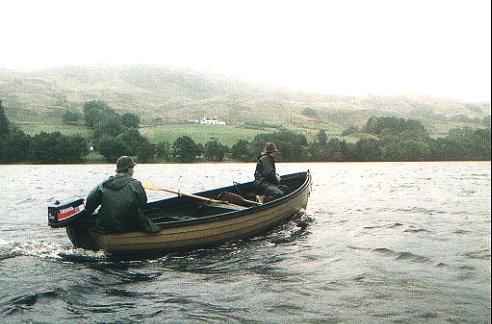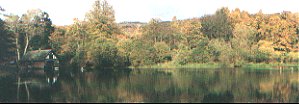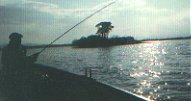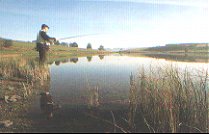
If Scotland is the home of golf it is equally
the home of trout and salmon fishing, and the names of Scottish trout and salmon flies are
famous wherever anglers cast their flies in the water.
Salmon can be
found in many Scottish rivers
But the successful angler will need to spend a little time researching where - and
when - the fish are best to be found. And if he chooses a top beat at a prime time he will
also need to spend a little money. Indeed some rivers are so special that it can almost
seem as if one must wait until death, debt or divorce provides a chance to get on the best
beats at the best time. And yet, with some searching, it is possible to find affordable
waters: one beat on the renowned Helmsdale, birth place of that famous fly the Willie
Gunn, can be fished for just £15 a day and good water on lesser rivers can be found for
about the same price.
Most salmon rivers are open by the early weeks
of February and the choice is endless with the best of the sport on the Halladale,
Helmsdale, Borgie, Naver and Strathy and on the longer rivers of the east, the Spey,
Findhorn and Don, the Dee and the North and South Esk where there is perhaps the best
chance of a springer on the fly.

A Bonanza of
Salmon
There is early fishing in the west. Loch Lomond and the River Leven can produce
salmon from opening day. Trolling is the usual method on the loch itself but there are sea
trout to be had on a dapped fly in the warmer days of summer. Then is the time of the
grilse run on the shorter rivers of the west, the Awe, the Orchy, the Spean and on dozens
of small spate rivers. Now it's the holiday fisherman's turn as the sea-trout rise to slim
flies fished during the gloaming of the short northern nights, and when a spot or rain can
bring bonanza of salmon to any small, unregarded river. This is the time to explore.
By late August when the hills are purple with
heather the first of the large autumn salmon coming up the river can bring tremendous
sport on some of the rivers of the Southwest, the Stinchar or the Doon. But autumn is the
time for the big rivers of the south, the east-flowing Tweed with its many tributaries
and, flowing south to the Solway, the Bladnoch and the Cree, the Annan and the Nith. Here
salmon can be fished until the last day of November. And in 6 short weeks you can start
again.
Days and Nights of Salmon Fishing in the River
Tweed
By Wiliam Scrope (1885) (pdf)

Brown Trout
Fishing
The lochs of Scotland's West Coast offer the visiting angler the opportunity to fish for
wild brown trout in one of the last great wildernesses of Western Europe. With literally
tens of thousands of hill lochs to choose from, the fisherman is spoilt for choice.
Various guides are available which will help fishermen decide on when and where to fish,
what techniques to use and where to hire boats and purchase tickets or get permission.
Visiting anglers should be aware the permission should be sought to gain access to and
fish these lochs and also that most Scottish lochs, whilst they may appear to hold large
numbers of fish, are fragile environments which can quickly deteriorate if over-fished.

Visiting anglers are asked to observe any catch
limits and, if such limits are not in force, to apply the practice of catch and release at
their discretion.
In Scotland's
south and east
The rainbow trout is now providing consistent and excellent sport in stillwaters
with first class facilities, easy access and some very large trout. From the Lothians and
Fife in the east, across to Ayrshire, Lanarkshire, the Renfrews, Dunbartonshire and Argyll
in the west, one is never far from a fishery well stocked with prime rainbows than can be
tempted by a well presented fly. From the Borders right through Central Scotland and up
into the Highlands and beyond, these fisheries are to be found. Some within sight of
suburbia, others tucked away in lowland hills giving an illusion of distance from
civilisation. Most of the best trout fisheries are members of the Association of Scottish
Stillwater Fisheries where the emphasis is on good facilities, quality fish and value for
money with extra friendly staff always ready with a word of advice on the best catching
flies to choose for a cast. The visiting angler will be delighted with all that is on
offer and at prices which as so much less expensive that might have been expected - and as
a financial bonus a rod licence is not required in Scotland.
Fast and Furious
If one fish were to symbolise the staggering breadth and beauty of Scottish fishing
it would surely be the wild brown trout. Wild brownies are found in the windswept loch of
Shetland where the summer sky barely darkens, the fertile machair lochs of the Hebrides,
the limestone lochs of Durness with their crystal waters and huge, wary trout. There are
high lochs and lochans hidden behind every fold of the Highlands and many more lost in the
wilderness of Rannoch Moor where bright spotted trout glint in the peaty waters. And each
loch is different. Some are alive with bright, scrappy little fish, others hold fewer, but
larger fish.

On some the sport is fast and furious, on others
it can be downright dour - until the day when, for some reason, every fish begins to move
and is ready to take. The magic of these waters is discovery.
Lure on the Tail
The variety of trout and trout waters is matched by the variety of fishing methods.
In fly fishing the larger waters favour the traditional "loch-style" drifts with
a long rod and team of traditional flies, or in the early and later months when the water
temperature is lower, a favourite lure like Ace of Spades or Cats Whisker will surely
attract trout. Whereas on the smaller bank fisheries, a normal 10 or 9.5 foot rod with a
team of traditional flies with perhaps a lure on the tail will catch fish. On rivers, a
team of wet flies fished down and across is probably the commonest method but dry flies
and upstream nymphs are often effective when the trout are rising. And the subtle art of
fishing the upstream wet fly was developed, of course, on the waters of the Tweed.
Endless Choice
Above all, Scotland is the place to explore and discover. The choice of fishing is
endless and exciting. But always Scotland. |

